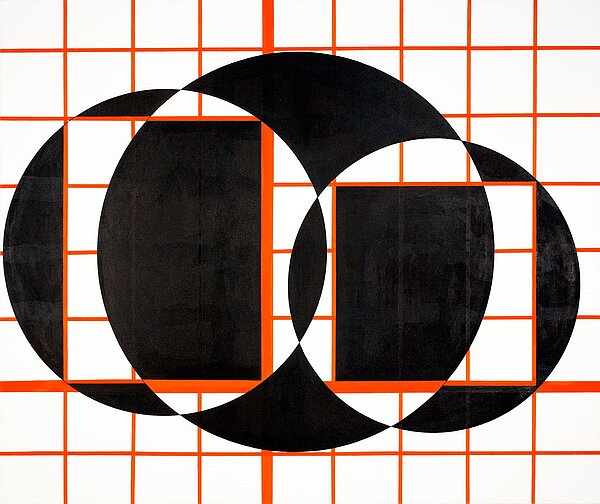Channa Horwitz
Circle and Square Negative, 2005
Acrylic on canvas
152,5 x 183 cm
© Artist
Photo: Gerhard Sauer
For over forty years the concept and performance artist Channa Horwitz produced her work in almost complete isolation from the art scene, and not until she was already over seventy did her achievements receive international acclaim. Her deep resolution to create her own position led her as a young woman to a number of art schools and ultimately to the California Institute of the Arts, with its interdisciplinary approach, where she studied in the early 1970s under among others Allan Kaprow and John Baldessari. Already her design for a lumino-kinetic sculpture, which she submitted in 1968 to the forward-looking exhibition Art and Technology at the Los Angeles County Museum of Art, experimented with the visualisation of time, rhythm, and movement, which she combined with the latest technological developments. Even if her contribution was never realised, it is regarded as the starting point for what probably is Horwitz’s most famous series, Sonakinatography, involving systems of graphic notation based on combinatorial principles that give visual form to sounds, time and colour.
The roots of Channa Horwitz’s creative output go back to an era in which the practice of art was primarily coloured by the creed of freedom, and pictures viewed as an expression of the painter's personal temperament. But unlike for instance the representatives of Abstract Expressionism, Horwitz arrived at the view that artistic freedom can only be achieved on the basis of system and logic, and created an art that built emphatically on a restricted language of forms and self-imposed rules. The painting Circle and Square Negative, one of a series begun in the mid-1960s, gives a clear idea of her principles. The aesthetic basis for the work is an orange coloured grid on a white ground, which emulates graph paper. On top of this comes a black and white superimposed arrangement involving three circles, a rectangle and a square, whose construction follows a pre-determined, four-step plan. Horwitz viewed this reduced imagery as an extreme form of concentration, because all shapes are contained in a circle and a square, just as black and white bring together every colour. Her system of rules did not however simply minimise her subjective decisions, but above all opened up countless possible variations for arriving at images. Thanks to the way the group of shapes joins up with the mathematical grid, and the images and ground are welded into a whole, the artist arrived at an ambivalent impression of a space in which the alternating positive and negative shapes switch to and fro, between surface, transparency and depth. (Hsiaosung Kok)
Channa Horwitz
1932 born in Los Angeles
2013 died in Los Angeles


